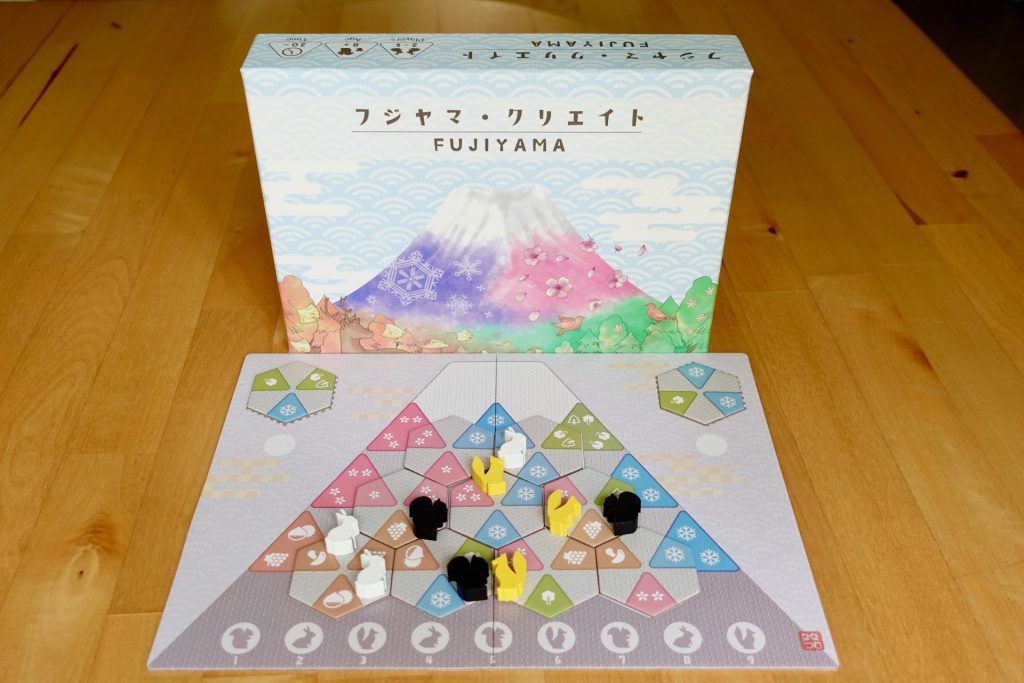
In Fujiyama, players create a version of Mount Fuji by setting in place various forests on the mountain that blossom during the four different seasons. Whilst doing so, they try to populate the flatlands with the most diverse group of forest animals to score the most points to win the game.
SET UP
The game is set up like so:

Each player receives a player mat of Mount Fuji and populates the base of the mountains with the corresponding 9 animal tokens: 3 of each rabbit, squirrel and fox – following the unique patterns on the mat. Then each player draws 11 season tiles face down to form an individual draw deck.
GAME PLAY

The objective of the game is to gain the most points by completing as many seasonal triangles and housing different animals in each flatland, ie. the gray areas between the forest triangles. Spring forests award the total number of cherry blossoms in each triangle. Summer forests award the product of the number of conifers and broadleaf trees. Autumn forests award combinations of 3 different food items with 9 points. All other Autumn forest combinations with one or two items gain 4 points. Each Winter forest awards the total number of winter forests + 3 points. So, a mat with 2 Winter forests will each score 5 points (2 Winter Forests + 3 points) for a total of 10 points (5 points x 2 forests).
Animals in the flatlands are scored based on their diversity. Flatlands with 3 different animals score 9 points, those with 2 different animals score 8 points and single animals score 3 points.
Drafting
The game is played over 9 rounds. In the first round of the game, players draw three tiles, selecting one tile as their trump tile which they may use in any round of the game. The remaining two tiles in hand, are offered to opponents to their left and to their right, placing said tiles face down on the corner of opponent’s mats closest to them.

Placement
Once all players have assigned tiles to their adjacent opponents, everyone flips them over and decides which of the two tiles they will choose to place on their mountain. Players reward the opponent whose tile they chose, with the animal token in line from the mountain base. A player choosing the tile on the left, will pass the animal token to the player on his left. If he chooses the tile on the right, he rewards the player on his right with the animal token instead. It is possible for a player to receive two animals, if both opponents on their left and right choose the tiles assigned to them by the same player. Or, they may receive none at all if neither adjacent opponents select the tiles they assigned.

Once everyone has passed on their animal tokens, players place their selected tiles anywhere on the 9 spaces on their player mat. Any animal tokens received this round are housed on the current tile played.
Refresh
In subsequent rounds, players draw one tile from their season deck and, with the un-played tile from the previous round, form a hand of 2 tiles. These two tiles are once again drafted to adjacent opponents on either side. After which, the next animal token in line is given to the opponent whose tile they have chosen to place in their mountain.

In the event a player chooses to place their trump tile instead, they do not pass their animal token along. This animal token may be placed on their trump tile after it has been played on the board. In the following Draw phase, they do not draw any new tiles. The two unused tiles assigned the previous round are drafted to their opponents instead. The game ends when all 9 spaces are filled with season tiles and the 9 animal tokens have been distributed. Season points and animal points are totaled for the final score and the player with the highest score wins.
FINAL THOUGHTS

Fujiyama is a very calm game with only one point of possible confusion. In our games, if players rushed through phases, there was the possibility of confusion in between the placement and redrafting for the next round. Because it is so straightforward, it can be easy to finish a round, pick up the next tile and draft tiles to another player’s mat before they have finished their turn and deluging them with tiles that further overwhelm. We found it helpful that everyone keep pace together to make tile management easier.
The gameplay reminded me of my years spent in Japan, trying to navigate similar social dynamics in actual Japanese society. The tile drafting mechanics for other players is exceptionally social. 50% of the game play is spent figuring out which tiles in hand best suited either player on our left and right. That sounds just about right. Consideration for others is a very strong virtue of the Japanese and it is considered polite company to be as helpful and thoughtful to others as it is in the game.
That is not to say that individuals do not have their own agenda. Clearly, there are benefits to putting others first in this game. Everyone is invested in other players’ successes because they are duly rewarded for drafting the best tile for their opponent in hopes to receive an animal token to better their score. Especially when you are eyeing a key animal to unlock the 9 point diversity combo.
A CASE FOR OVER-CONSIDERATION

My one pet peeve with the game was not with the gameplay, but with the game components. In trying to make scoring simple, they have made the score sheet unnecessarily complex. The 5 columns, one for each of the 4 seasons, as well as one for failed attempts, are supposed to make it easier to calculate individual tiles based on seasons. Instead, to use the score sheet, each forest on a player’s mat is scored on a different row for each triangle and a different column for forest type. So your eyes have to constantly realign for both row and column each time, which makes it anti-intuitive and difficult to follow.
I would much prefer scoring keys printed on the board where they can be referenced throughout the game, although I understand it could be a matter of aesthetics. Perhaps on the side of the box like Ohanami, or even a player aid card would have easily sufficed as they did with Ajisai, which is being concurrently released in this campaign. For the score sheet, a single row of numbers that players fill up next to the respective tile columns would be much easier to add up. That is what we ended up doing since we also found there were insufficient sheets on the score pad. In our play tests with 3 and 4 players, over the course of 4 plays, we went through 16 sheets. I currently have about 18 sheets left and not very many more plays to score on a pad that is only single-side printed. So, if you do run out, scoring on a separate paper might just be easier.











Add Comment